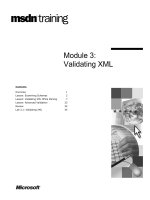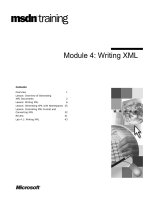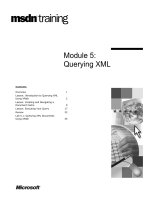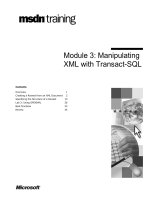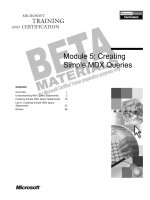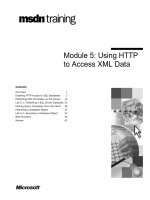Module 5: Querying XML
Bạn đang xem bản rút gọn của tài liệu. Xem và tải ngay bản đầy đủ của tài liệu tại đây (1004.22 KB, 50 trang )
Contents
Overview 1
Lesson: Introduction to Querying XML
Using XPath 2
Lesson: Creating and Navigating a
Document Cache 9
Lesson: Executing Your Query 17
Review 33
Lab 5.1: Querying XML Documents
Using XPath 35
Module 5:
Querying XML
Information in this document, including URL and other Internet Web site references, is subject to
change without notice. Unless otherwise noted, the example companies, organizations, products,
domain names, e-mail addresses, logos, people, places, and events depicted herein are fictitious,
and no association with any real company, organization, product, domain name, e-mail address,
logo, person, place or event is intended or should be inferred. Complying with all applicable
copyright laws is the responsibility of the user. Without limiting the rights under copyright, no part
of this document may be reproduced, stored in or introduced into a retrieval system, or transmitted
in any form or by any means (electronic, mechanical, photocopying, recording, or otherwise), or
for any purpose, without the express written permission of Microsoft Corporation.
Microsoft may have patents, patent applications, trademarks, copyrights, or other intellectual
property rights covering subject matter in this document. Except as expressly provided in any
written license agreement from Microsoft, the furnishing of this document does not give you any
license to these patents, trademarks, copyrights, or other intellectual property.
©2002 Microsoft Corporation. All rights reserved.
Microsoft, MS-DOS, Windows, Windows NT, Win32, Active Directory, ActiveX, BizTalk,
IntelliSense, JScript, Microsoft Press, MSDN, SQL Server, Visual Basic, Visual C#, and
Visual Studio are either registered trademarks or trademarks of Microsoft Corporation in the
United States and/or other countries.
The names of actual companies and products mentioned herein may be the trademarks of their
respective owners.
Module 5: Querying XML iii
Instructor Notes
This module explains the process of querying an Extensible Markup Language
(XML) document by using the XML Path Language (XPath). It explains how to
write code to load an XML document and how to create a navigation cursor by
using an XPathNavigator object. It also explains how to create your query by
using an XPathDocument object and how to examine the result types. In
addition, this module describes how to compile your query and evaluate your
results.
After completing this module, students will be able to:
Describe the business reasons for querying Extensible Markup Language
(XML) documents by using the XML Path Language (XPath).
Cache XML data for querying by using an XPathDocument object.
Create an XPathNavigator object to navigate through an XML document.
Compile and evaluate the result of an XPathExpression object.
Iterate through an XmlNodeList object returned by an XPath expression.
To teach this module, you need the following materials:
Microsoft
®
PowerPoint
®
file 2663A_05.ppt
2663A_05_code.htm
Module 5, “Querying XML”
Instructor-led demonstration file
To prepare for this module:
Read all of the materials for this module.
Complete the lab.
Practice the instructor-led demonstration and code examination.
The demonstrations in this module consist of a demonstration and code
walkthrough of querying an XML document. To prepare for these
demonstrations, perform the demonstration steps as they are written and
prepare to explain how the code works.
In this module some of the PowerPoint slides provide hyperlinks that open a
code samples page in the Web browser. The code samples page provides a way
to show and discuss code samples when there is not enough space for the code
on the PowerPoint slide. It also allows students to copy code samples directly
from the browser window and paste them into a development environment. All
of the linked code samples for this module are in a single .htm file.
To open a code sample, click the appropriate hyperlink on the slide. To navigate
between code samples in a particular language, use the table of contents
provided at the top of the code page. Each hyperlink opens a separate instance
the Web browser, so it is a good practice to click Back in Internet Explorer
after you view a code sample. This will close the browser window and return
you to the PowerPoint presentation.
Presentation:
60 minutes
Lab:
60 minutes
Required materials
Preparation tasks
Hyperlinked Code
Examples
iv Module 5: Querying XML
How to Teach This Module
This section contains information that will help you to teach this module.
Lesson: Introduction to Querying XML Using XPath
This section describes the instructional methods for teaching each topic in this
lesson.
This lesson introduces XPath and the reasons for using it. To understand the
rest of the module, the students must understand how XPath expressions are a
navigational language for XML documents. Stress that XPath is an XML
language that provides access to nodes and their contents, wherever the nodes
are located in an XML document.
The role of the World Wide Web Consortium (W3C) in the development of
XPath in conjunction with the development of XQuery illustrates the dynamic
nature of XML technologies and languages. Stress that this evolution is ongoing
and requires continual adjustments and refinements by both vendors and
developers. However, stress that the development is not random.
This topic introduces students to the steps in the query process. Emphasize that
these steps are general. For example, students might compile the query or they
might not. Explain that this information is covered in the third lesson of this
module.
In this demonstration, you will load a product catalog document and
demonstrate multiple queries. These queries have different return types,
including node sets, numbers, strings, and Boolean values.
Lesson: Creating and Navigating a Document Cache
This section describes the instructional methods for teaching each topic in this
lesson.
This topic explains why to use an XPathDocument object to cache data.
Emphasize that using the XPathDocument object provides a way for students
to query data in a read-only manner. This topic also explains how to preserve
all white space in the source XML document. Explain how XmlSpace.Preserve
and XmlSpace.Default function.
To navigate through an XML source document, students must create a cursor
by creating an XPathNavigator object. In this topic, students will learn how to
use the CreateNavigator() method to create an XPathNavigator object.
This topic defines five methods that students can use to position the navigator
by traversing the XML document.
Why Query XML Using
XPath?
What Is the Query
Process?
Demonstration:
Querying XML Using
XPath
What Is an
XPathDocument Object?
How to Create a
Navigato
r
How to Navigate Nodes
in an XPathDocument
Module 5: Querying XML v
Lesson: Executing Your Query
This section describes the instructional methods for teaching each topic in this
lesson.
In this topic, students will learn how to create and compile a query by using the
Compile() method. Emphasize that one advantage of compiling a query is that
doing so allows you to determine the data type of the information returned by
the query.
This topic explains how to use the Evaluate() method to evaluate number
return types. Emphasize that the Evaluate() method returns a typed result.
This topic explains how to use the Select() methods to evaluate node return
types. Explain that students can either compile the query into an
XPathExpression object and then use the Select() method of the
XPathNavigator object, or they can execute a string XPath expression directly
by using one of the Select() methods of the XPathNavigator object.
Students might have noticed in the Select() method example in the previous
topic that the resulting nodes are stored in an XPathNodeIterator. This topic
explains how to use an XPathNodeIterator to iterate through a node set.
Emphasize that students must call the MoveNext() method to move the
XPathNodeIterator to the first node in the selected set.
Explain the code underlying the application that you demonstrated at the
beginning of this module.
Review
There are several multiple-choice review questions at the end of the chapter.
Review these questions with your students before proceeding to the lab.
The review questions are mostly based on conceptual understanding and
procedures that were covered thoroughly in the module. You can use a
discussion format to answer the questions so that every student gets the benefit
of knowing the right answers.
1. If the students are not sure what method to call to move the
XPathNodeIterator to the first node in the selected set, review the third
lesson.
2. If students have difficulty with this question, review XmlSpace members,
especially the default and the preserve members.
3. If students answer that you cannot execute a query directly without
compiling it, correct this perception. At the same time, emphasize the
benefits of compiling queries.
4. This question explores the distinctions between the Evaluate() and Select()
methods.
How to Create and
Compile a Query
How to Execute XPath
Expressions That Return
Numbers
How to Execute XPath
Expressions That Return
Node Sets
How to Iterate Through a
Node Set
Code Examination
vi Module 5: Querying XML
Lab 5.1: Querying XML Documents Using XPath
Before beginning this lab, students should have completed the module and
answered the review questions. Students will need to be able to perform most of
the tasks that they learned in the lessons.
Customization Information
This section identifies the lab setup requirements for a module and the
configuration changes that occur on student computers during the labs. This
information is provided to assist you in replicating or customizing
Microsoft Official Curriculum (MOC) courseware.
Lab Setup
There are no lab setup requirements that affect replication or customization.
Lab Results
There are no configuration changes on student computers that affect replication
or customization.
Module 5: Querying XML 1
Overview
Introduction to Querying XML Using XPath
Creating and Navigating a Document Cache
Executing Your Query
*****************************
ILLEGAL FOR NON
-
TRAINER USE
******************************
This module explains the process of querying an Extensible Markup Language
(XML) document by using the XML Path Language (XPath). It explains how to
write code to load an XML document and how to create a navigation cursor by
using an XPathNavigator object. It also explains how to create your query by
using an XPathDocument object and how to examine the result types. In
addition, this module describes how to compile your query and evaluate your
results. Because an XPath expression can return a set of nodes, you will learn
how to iterate through a set of nodes by using an XPathNodeIterator object.
After completing this module, you will be able to:
Describe the business reasons for querying XML documents by using
XPath.
Cache XML data for querying by using an XPathDocument object.
Create an XPathNavigator object to navigate through an XML document.
Compile and evaluate the result of an XPathExpression object.
Iterate through an XmlNodeList object returned by an XPath expression.
Introduction
Objectives
2 Module 5: Querying XML
Lesson: Introduction to Querying XML Using XPath
Why Query XML Using XPath?
What Is the Query Process?
Demonstration: Querying XML Using XPath
*****************************
ILLEGAL FOR NON
-
TRAINER USE
******************************
In this lesson, you will gain an understanding of XPath and how you can use
XPath to locate parts of XML documents and navigate through a document that
is represented as a tree of nodes.
After completing this lesson, you will be able to:
Describe the business reasons for querying XML documents by using
XPath.
Describe the steps in the querying process.
Introduction
Lesson ob
jectives
Module 5: Querying XML 3
Why Query XML Using XPath?
You can use XPath to:
Search
Filter
Summarize
XPath : XML :: Transact-SQL : SQL Server
Transact-SQL provides a standard language for
manipulating relational database objects
XPath provides a standard language for navigating an
XML document as a hierarchical tree of nodes
*****************************
ILLEGAL FOR NON
-
TRAINER USE
******************************
XPath is a programming language developed by the World Wide Web
Consortium (W3C) specifically to address the nodes of an XML source. XPath
is also well suited to querying an XML source. You can use XPath to extract
from an XML source whatever pattern of content or XML structure you require.
Some of the functionality of XPath is similar to the functionality of the
Document Object Model (DOM). For example, by using the DOM, you can
locate a certain piece of XML data by node type. However, the use of XPath to
specify location information in an XML document is far more pervasive than
the use of the DOM. What then is XPath, and why is it the technology of choice
for querying XML?
XPath was developed in part to correct some of the limitations inherent in
querying XML by using the DOM. XPath code that addresses and navigates
through nodes is much simpler than similar code written for the DOM.
XPath allows you to navigate through the nodes of an XML source. You can
also combine XPath navigation with other programming techniques. For
example, you can use XPath to locate parts of an XML document to generate
results for a query with XQuery and XML Views in Microsoft
®
SQL Server
™
2000.
Introduction
Wh
y use XPath?
4 Module 5: Querying XML
The following table illustrates how you can use XPath.
Example
Action
Microsoft .NET Framework
objects used
Get all the <ProductName>
elements in a document with a
price attribute value > $12.95.
Search An XPathDocument object is
optimized for query. Use an XPath
expression to locate nodes.
Change price information in
an XML product catalog.
Locate
information
to modify
An XmlDocument object provides an
implementation of the W3C DOM.
Use an XPath expression to locate
nodes to be modified.
Only find what matches a
specified search criterion.
Filter You can apply an Extensible
Stylesheet Language for
Transformation (XSLT) style sheet to
an XPathDocument object. The
XSLT style sheet often contains an
XPath expression.
Get a count of the number of
parts that are out of stock.
Summarize You can query an XPathDocument
object to provide a count or sum of
information in the document, by using
an XPath expression.
Examples of using
XPath
Module 5: Querying XML 5
What Is the Query Process?
MoveToRoot( )
MoveToRoot( )
MoveToNext( )
MoveToNext( )
MoveToPrevious( )
MoveToPrevious( )
MoveToFirstChild( )
MoveToFirstChild( )
MoveToParent( )
MoveToParent( )
.ReturnType
XPathDocument
XPathDocument
CreateNavigator
CreateNavigator
XPathNavigator
XPathNavigator
Evaluate( )
Evaluate( )
Select( )
Select( )
Compile( )
Compile( )
Boolean
Boolean
String
String
Double
Double
NodeSet
NodeSet
XPathNodeIterator
MoveNext( ) For Each
XPathExpression
5. Check the ReturnType
1. Load XPathDocument
2. Create XPathNavigator
4. Compile XPathExpression
3. Create the Query
*****************************
ILLEGAL FOR NON
-
TRAINER USE
******************************
Querying by using XPath provides a way for your application to navigate from
one node to the next, and to perform various operations along the way.
To query an XML document, you generally perform the following steps:
1. Write code to load an XML document into an appropriate cache.
You can use an XmlDocument object, XPathDocument object, DataSet,
or XmlDataDocument, depending on how you want to access the
information.
2. Create a navigator to navigate through the XML document.
You can use an XPathNavigator object to efficiently select nodes in an
XML document.
3. Create the query.
You generally create an XPath expression to select nodes in the cache. You
can execute a query directly, or you can compile it if you expect to run the
query multiple times.
4. Optionally, compile the query and determine the result type.
XPath queries can return nodes, strings, or other types of values. You must
either know the types of results that you expect the query to produce, or
determine the return type programmatically.
If you compile the query, you can determine the type of information that
will be returned before you execute the query. In addition, compiling the
query will result in faster execution.
5. Evaluate the results.
Depending on the type of information returned, you can process results by
iterating through a set of nodes, or simply process the values returned.
Introduction
Querying an XML
document
6 Module 5: Querying XML
Demonstration: Querying XML Using XPath
Load document - XPathDocument
Load document - XPathDocument
Create navigator - XPathNavigator
Create navigator - XPathNavigator
Create query - XPathExpression
Create query - XPathExpression
Optionally, compile query and examine result
type
Optionally, compile query and examine result
type
Evaluate results
Evaluate results
*****************************
ILLEGAL FOR NON
-
TRAINER USE
******************************
In this demonstration, you will see how you can query an XML document
containing product catalog information. The application:
Loads an XML document into a cache optimized for query.
Creates a navigator to navigate nodes in the document.
Compiles an XPath query and determines the return type.
Evaluates the query and generates results.
Processes and displays the results.
You should also use this demonstration to review simple XPath location paths
and functions.
To load the product catalog document
1. In Microsoft Internet Explorer, open ProductCatalogData.xml and examine
the structure of the document. Notice that each category element contains
category information and a product element containing all products in that
category.
2. In Microsoft Visual Studio
®
.NET, open the project file for the Querying
demonstration. Open the C# or Microsoft Visual Basic
®
project file as
appropriate.
3. Run the application.
4. Load the data file ProductCatalogData.xml by using the application. The
application loads data from the file into an XPathDocument object.
Introduction
Demonstration
Module 5: Querying XML 7
To compile and evaluate queries that return node sets
• For each XPath expression in the following table, click Evaluate XPath,
examine the return type, and then click Execute XPath and explain the
results.
XPath expression Description
//text() All text nodes in the document at
any level
/ The root element node
/node()/node() The element or text nodes that are
grandchildren of the current node
/node()/node()/node() The element or text nodes that are
great-grandchildren of the current node
//Product/ProductName All product name elements that are
descendants of a product element
//AllCategories/Category/CategoryName All category names
//CategoryName All category names
//Category[CategoryID = 2]/
Products/Product/ProductName
All product names in category 2
To compile and evaluate queries that return numbers
• For each XPath expression in the following table, click Evaluate XPath,
examine the return type, and then click Execute XPath and explain the
results.
XPath expression Description
count(node) Number of root elements (1)
count(node()/node()) Number of children of the root element
count(//Product) Number of product elements
count(//Category[CategoryID = 2]/
Products/Product)
Number of products in category 2
8 Module 5: Querying XML
To compile and evaluate queries that return strings
• The following XPath expression concatenates the first three grandchildren
nodes of the current node. Click Evaluate XPath, examine the return type,
and then click Execute XPath and explain the results.
concat(node()/node()/node()[1],
" ",node()/node()/node()[2], " ",node()/node()/node()[3])
To compile and evaluate queries that return Boolean values
1. For each XPath expression in the following table, click Evaluate Xpath,
examine the return type, and then click Execute XPath and explain the
results.
XPath expression Description
starts-with(//Product/ProductName[1], "C") Does the first product name begin
with the letter “C”? (yes)
starts-with(//Product/ProductName[1], "D") Does the first product name begin
with the letter “D”? (no)
2. Close the application.
Module 5: Querying XML 9
Lesson: Creating and Navigating a Document Cache
What Is an XPathDocument Object?
How to Create a Navigator
How to Navigate Nodes in an XPath Document
*****************************
ILLEGAL FOR NON
-
TRAINER USE
******************************
In this lesson, you will gain an understanding of how to prepare to query an
XML document. To query an XML document, you must load the XML
document and create a navigator by creating an XPathNavigator object.
After completing this lesson, you will be able to:
Load an XML document into an XPathDocument object.
Create a navigator by creating an XPathNavigator object.
Navigate an XPathDocument by using XPathNavigator methods.
Introduction
Lesson ob
jectives
10 Module 5: Querying XML
What Is an XPathDocument Object?
Use XPathDocument constructor
You can create an XPathDocument from:
Stream
File
TextReader
XmlReader
XPathDocument doc = new XPathDocument(…);
XPathDocument doc = new XPathDocument(…);
C# ExampleVisual Basic Example
*****************************
ILLEGAL FOR NON
-
TRAINER USE
******************************
Before you can query XML data, you must first load the data into a cache. The
Microsoft .NET Framework contains several objects that can cache XML data.
These include the XmlDocument, XPathDocument, and XmlDataDocument
objects. The choice of which cache to use depends on what you need to do with
the data.
If you expect to query data in a read-only manner from an XML source, you
should use an XPathDocument object to cache the data. The XPathDocument
object provides a read-only, in-memory cache for XML data that is optimized
for querying with XPath and for applying XSLT style sheets. You can also use
an XPathDocument object if you want to navigate through the individual
nodes in the document.
You can also query, navigate, and apply XSLT transformations to data in an
XmlDocument object. However, using the XmlDocument rather than the
XPathDocument object is not as efficient for querying and applying style
sheets. XmlDocument is the .NET Framework implementation of the DOM
and is intended for modifying the data.
You can create a new XPathDocument object and populate it with data by
using the object’s constructor. This constructor is overloaded to accept data
from a stream, file, TextReader, or XmlReader.
Introduction
Why use an
XPathDocument to
cache data?
Why not use an
XmlDocument to cache
data?
Creating a new
XPathDocument ob
ject
Module 5: Querying XML 11
The following example illustrates how to create a new XPathDocument object:
// C#
XPathDocument doc = new XPathDocument("C:\CatalogFile.xml");
'Visual Basic
Dim doc As XPathDocument = New _
XPathDocument("C:\CatalogFile.xml")
You can optionally specify to preserve the white space of the XML source in
the XPathDocument object, when the data source is a file or an XmlReader.
The optional parameter XmlSpace can have the following values.
Value Description
XmlSpace.Default Preserve only the significant white space.
XmlSpace.Preserve Preserve all white space.
XmlSpace.None Do not preserve white space.
The following example illustrates how to preserve all white space in the source
XML document:
// C#
//Create an XmlTextReader
XmlTextReader CatalogReader;
//Code to populate the reader from a file…
//…
//Create and populate the XPathDocument, preserving all
//white space
XPathDocument doc = new XPathDocument(CatalogReader,
XmlSpace.Preserve);
'Visual Basic
'Create an XmlTextReader
Dim CatalogReader As XmlTextReader
'Code to populate the reader from a file…
'…etc…
'Create and populate the XPathDocument, preserving all white
'space
Dim doc As XPathDocument = New _
XPathDocument(CatalogReader,XmlSpace.Preserve)
Example
Preserving white space
Example
12 Module 5: Querying XML
How to Create a Navigator
Create an XPathNavigator object
Use the CreateNavigator method
C# Example
Visual Basic Example
*****************************
ILLEGAL FOR NON
-
TRAINER USE
******************************
To create a query, you must create a navigation cursor to navigate through the
XML document you want to query. You create a navigator by using the
CreateNavigator() method to create an XPathNavigator object.
XPathNavigator provides read-only, random access to the data in the XML
document you loaded.
The XPathNavigator object is based on the XPath data model and provides the
methods required to implement XPath queries over any data store. You can also
use XPathNaivgator methods to traverse the nodes in the cache.
To create an XPathNavigator object, use the CreateNavigator() method of the
XPathDocument class. The XPathNavigator class implements the
IXPathNavigable interface.
Introduction
How to create an
XPathNavigato
r
Module 5: Querying XML 13
The following example creates an XPathNavigator object:
// C#
//Create a string to hold the data file path
String fileName = @"books.xml";
//Create and populate an XPathDocument
XPathDocument doc = new XPathDocument(fileName);
//Create a navigator on the document
XPathNavigator nav = doc.CreateNavigator();
'Visual Basic
'Create a string to hold the data file path
Dim fileName As String = "books.xml"
'Create and populate an XPathDocument
Dim doc As XPathDocument = New XPathDocument(fileName)
'Create a navigator on the document
Dim nav As XPathNavigator = doc.CreateNavigator()
The XPathNavigator object has methods for selecting a set of nodes based on
criteria in an XPath expression. You can also use methods to navigate in an
XPathDocument object in a way similar to how you traverse a DOM tree.
You will see how to use the Select() methods with an XPath expression in the
next lesson, Executing Your Query.
You will see how to traverse nodes by using navigational methods in the next
topic.
Example
Methods for returning
nodes
14 Module 5: Querying XML
How to Navigate Nodes in an XPathDocument
Moves the navigator to the first child of
a node
MoveToFirstChild
Moves the navigator to the parent of the
current node
MoveToParent
Moves the navigator to the previous
sibling of the current node
MoveToPrevious
Moves the navigator to the next sibling
of the current node
MoveToNext
Moves the navigator to the root of the
document
MoveToRoot
.
Action
Action
Method
Method
C# ExampleVisual Basic Example
*****************************
ILLEGAL FOR NON
-
TRAINER USE
******************************
After you create an XPathNavigator over an XPathDocument, you can
traverse the nodes in the document or access individual nodes in a random-
access manner. You position the navigator on individual nodes by using various
methods of the XPathNavigator class.
When you use an XPathNavigator, there is a concept of the current node. You
can set the current node in two primary ways: by using an XPathExpression
object as part of a Select() method, or by using use navigational methods. You
will use the Select() methods in the next lesson. You can use the following
navigational methods to position the navigator by traversing the XML.
Method Action
MoveToRoot() Moves the navigator to the root of the document.
MoveToNext() Moves the navigator to the next sibling of the current node.
MoveToPrevious() Moves the navigator to the previous sibling of the current
node.
MoveToFirstChild() Moves the navigator to the first child of a node. Only valid on
nodes that have children.
MoveToParent() Moves the navigator to the parent of the current node. Not
valid for the root node, because the root node has no parent.
Introduction
How to traverse
document nodes by
using an XPathNavigato
r
